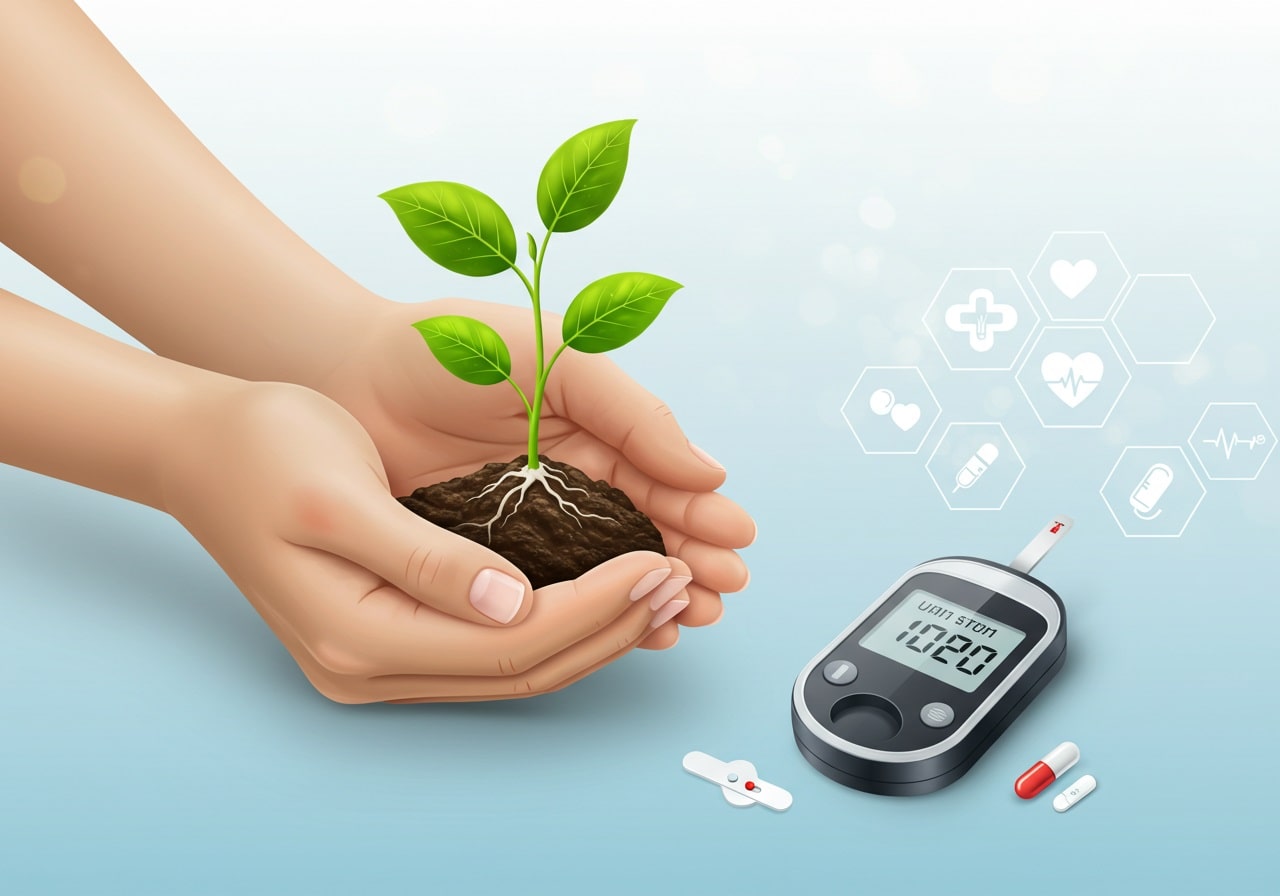By Sarah Johnson, Living with Type 2 Diabetes since 2020
When my phone rang that Tuesday morning three years ago, I wasn’t expecting my doctor to use the word “diabetes.” Like many people, I had a vague understanding of what diabetes was something about sugar, insulin, and avoiding desserts. But in that moment, as my doctor explained my test results, I realized how little I actually knew about a condition that would become part of my daily life.
I remember hanging up and immediately Googling “can you cure diabetes?” before spiraling into a mix of confusion and fear. If you’re recently diagnosed or searching for someone you care about, I get it. The good news? While we don’t have a complete cure yet, understanding and managing diabetes has come a remarkably long way. And yes, for some types of diabetes, remission is absolutely possible.
What is Diabetes Mellitus?
Diabetes mellitus is a chronic metabolic disorder characterized by elevated blood glucose (sugar) levels. But to truly understand diabetes, we need to dive into how our bodies normally process glucose.
Your body breaks down most of the food you eat into glucose, which is released into your bloodstream to fuel everything from brain function to muscle movement. For glucose to enter your cells and provide energy, it needs insulin a hormone produced by beta cells in your pancreas.
Think of insulin as a key and your cells as rooms with locked doors. When blood glucose rises (like after eating), the pancreas produces insulin, which unlocks cell doors, allowing glucose to enter and be used for energy. This keeps blood glucose levels within a healthy range.
In diabetes, this system breaks down in one of two ways:
The pancreas doesn’t produce enough insulin (or any at all)
The body’s cells don’t respond properly to insulin (known as insulin resistance)
The result? Glucose builds up in the bloodstream instead of entering cells, leading to high blood sugar (hyperglycemia) and a cascade of health issues if left untreated.
Types of Diabetes
Diabetes isn’t a one-size-fits-all condition. There are several types, each with different causes and management approaches.
Type 1 Diabetes
This is an autoimmune disease where the body’s immune system mistakenly attacks and destroys the insulin-producing beta cells in the pancreas. Without these cells, the body produces little to no insulin.
My cousin was diagnosed with Type 1 at age 12. She describes it as “having to be your own pancreas 24/7.” Every carbohydrate she consumes must be counted, calculated, and matched with the right insulin dose. It’s exhausting but manageable.
People with Type 1 diabetes need to take insulin throughout their life as their bodies cannot produce it. Unfortunately, there is currently no cure for Type 1 diabetes, but research on immunotherapy and pancreatic islet transplantation shows promise.
Type 2 Diabetes
Type 2 diabetes accounts for about 90-95% of all diabetes cases. In type 2, the body becomes resistant to insulin, and over time, the pancreas can’t produce enough insulin to overcome this resistance.
Unlike Type 1, Type 2 diabetes develops gradually. Many factors contribute to its development, including:
Genetic predisposition
Being overweight or obese
Physical inactivity
Age (risk increases after 45)
History of gestational diabetes
The encouraging news? Type 2 diabetes can sometimes be managed without medication through lifestyle changes, and some people achieve remission through diet, exercise, and weight loss.
Gestational Diabetes
This type occurs during pregnancy in women who didn’t have diabetes before. Hormonal changes during pregnancy can cause insulin resistance, leading to high blood glucose. While gestational diabetes usually resolves after childbirth, it increases the risk for type 2 diabetes later in life for both mother and child.
The Diagnosis Journey
I still remember sitting in that doctor’s office, confused when my physician explained that my blood glucose was “significantly elevated.”
“But I don’t feel sick,” I protested.
“That’s actually part of the problem,” she explained. “Many people don’t have obvious symptoms until complications develop.”
The classic symptoms of diabetes include:
Frequent urination
Excessive thirst
Unexplained weight loss
Extreme hunger
Blurred vision
Fatigue
Slow-healing sores
But here’s the tricky part many people with type 2 diabetes have no symptoms at all, at least initially. Diagnosis comes through blood tests that measure glucose levels, typically a fasting blood glucose test, an oral glucose tolerance test, or an A1C test that measures average blood glucose over the past 2-3 months.
Managing Diabetes: A Multifaceted Approach
Living well with diabetes requires a comprehensive strategy. While there’s no one-size-fits-all treatment plan, these components are essential for most people:
Lifestyle Changes
Diet and exercise form the foundation of diabetes management, especially for type 2 diabetes.
Diet
The good news? Managing diabetes doesn’t mean giving up everything you enjoy. The goal is to choose healthier options and control portions. This typically means:
Emphasizing fiber-rich vegetables, fruits, and whole grains
Including lean proteins and healthy fats
Limiting processed foods, refined carbs, and added sugars
Being mindful of portion sizes
One approach that’s worked for me is the plate method: fill half your plate with non-starchy vegetables, a quarter with lean protein, and a quarter with carb-containing foods.
Some people with type 2 diabetes find success with low-carb diets. One Reddit user shared: “I have been diagnosed with diabetes t2 by end of March and refused to take metformin… Just followed strict diet with less carb (no rice/wheat but mainly quinoa and millet roti) along with 50% green leafy veggie and 25% protein… Proud to say that my a1c came down from 6.5 to 5.7 in 1.5 months without any medication”.
But don’t throw away all your pasta just yet! Different approaches work for different people. For some, intermittent fasting has shown promise in helping achieve remission.
Exercise
Physical activity improves insulin sensitivity, helping your body use glucose more effectively. Aim for at least 150 minutes of moderate-intensity exercise per week, spread over several days.
But you don’t need to become a marathon runner! Find activities you enjoy walking, swimming, dancing, gardening and make them part of your routine.
After my diagnosis, I started with just 10-minute walks after meals (when blood sugar tends to spike). Those small steps made a measurable difference in my glucose readings, which motivated me to gradually increase my activity level.
Medications for Diabetes
When lifestyle changes aren’t enough, medications can help. The options vary depending on the type of diabetes:
For Type 1 Diabetes
Insulin is essential for everyone with type 1 diabetes, typically through:
Basal (long-acting) insulin to provide background coverage
Bolus (rapid-acting) insulin at mealtimes
Insulin can be administered via injections or an insulin pump, which delivers small amounts continuously throughout the day.
For Type 2 Diabetes
Treatment typically starts with metformin, which decreases glucose production in the liver and improves insulin sensitivity. If metformin alone isn’t sufficient, other medications may be added:
DPP-4 inhibitors
SGLT2 inhibitors
GLP-1 receptor agonists
Sulfonylureas
Thiazolidinediones
Insulin (for some people with type 2 diabetes)
Each class works differently, and your doctor will recommend options based on your specific needs, other health conditions, and preferences.
Monitoring Blood Glucose
Regular monitoring helps you understand how food, activity, medications, and stress affect your blood glucose. Options include:
Traditional fingerstick testing
Continuous glucose monitors (CGMs), which measure glucose levels every few minutes
Modern CGMs can connect to smartphones and even alert you when glucose levels are trending too high or too low a game-changer for many people with diabetes.
The Psychological Impact: The Part Nobody Talks About
Living with diabetes isn’t just physically challenging it takes a mental toll too. Diabetes distress and burnout are real phenomena that aren’t discussed nearly enough.
I hit a wall about six months after diagnosis. The constant monitoring, medication adjustments, and dietary vigilance felt overwhelming. What helped? Connecting with others who understood through an online diabetes community and working with a therapist who specialized in chronic illness.
Remember: managing diabetes is a marathon, not a sprint. Be kind to yourself on difficult days, and celebrate your successes, however small they may seem.
Complications and Prevention
I won’t sugarcoat it (pun intended) uncontrolled diabetes can lead to serious complications, including:
Heart disease and stroke
Kidney disease
Nerve damage (neuropathy)
Eye damage (retinopathy)
Foot problems
The good news? These complications aren’t inevitable. Keeping blood glucose, blood pressure, and cholesterol within target ranges significantly reduces your risk.
Regular check-ups are essential including comprehensive eye exams, foot examinations, kidney function tests, and cardiovascular assessments.
Research and Hope for Cures
While diabetes management has improved dramatically, researchers continue to search for cures. Here’s what’s happening on the frontier:
For Type 1 Diabetes
Immunotherapy: Researchers are developing treatments that target the immune system to prevent or reverse the autoimmune attack on beta cells. The monoclonal antibody teplizumab has shown promise in delaying the onset of type 1 diabetes in high-risk individuals.
Pancreatic Islet Transplantation: This procedure transplants insulin-producing islet cells from a donor pancreas into a person with type 1 diabetes. While promising, recipients need immunosuppressive drugs to prevent rejection.
Stem Cell Research: Scientists are working to develop insulin-producing cells from stem cells, which could potentially replace destroyed beta cells.
For Type 2 Diabetes
Weight-Loss Surgery: Bariatric surgery has shown remarkable results for some people with type 2 diabetes and obesity, sometimes leading to long-term remission.
New Medications: Novel drug classes continue to emerge, improving both insulin secretion and sensitivity.
Lifestyle Interventions: Research continues on how specific dietary approaches, intermittent fasting, and exercise protocols might induce remission in type 2 diabetes.
Technology Advancements
The “artificial pancreas” represents one of the most exciting developments closed-loop systems that combine continuous glucose monitors with insulin pumps that automatically adjust insulin delivery based on glucose readings. These systems essentially mimic a healthy pancreas, reducing the mental burden of constant decision-making.
Living Well with Diabetes
Despite the challenges, many people live full, active lives with diabetes. Here are some practical tips that have helped me and countless others:
Build a support team: Include healthcare providers who specialize in diabetes, but also friends, family, and others with diabetes who understand your journey.
Use technology to your advantage: Apps for carb counting, medication reminders, and exercise tracking can simplify management.
Prepare for emergencies: Always carry fast-acting glucose for low blood sugar episodes, and make sure loved ones know what to do in case of severe hypoglycemia.
Be flexible: Some days will be harder than others. Learn from challenges rather than beating yourself up over them.
Stay informed: Diabetes research and treatment options evolve rapidly. Keep learning, but be wary of “miracle cures” promoted online.
Conclusion
Living with diabetes requires daily attention and care, but it doesn’t define who you are or limit what you can achieve. From Olympic athletes to world leaders, people with diabetes have demonstrated that this condition need not stand in the way of your dreams and goals.
Whether you’re newly diagnosed, supporting someone with diabetes, or simply curious about this common condition, I hope this guide provides valuable insights and practical information.
The future of diabetes care looks promising, with research advancing on multiple fronts. Until a cure is found, we can embrace the tools, technologies, and strategies available to live well with diabetes today.
Have you been affected by diabetes? What strategies have worked for you? I’d love to hear your experiences in the comments below your insight might just help someone else on their diabetes journey.








